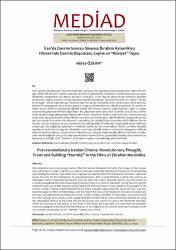| dc.contributor.author | Özkan, Hülya | |
| dc.date.accessioned | 2022-03-02T10:20:36Z | |
| dc.date.available | 2022-03-02T10:20:36Z | |
| dc.date.issued | 2020 | en_US |
| dc.identifier.citation | Özkan, H. (2020). İran’da devrim sonrası sinema: İbrahim Hatemikiya filmlerinde devrim düşüncesi, cephe ve “hüviyet” inşası. Medya ve Din Araştırmaları Dergisi, 3(1), 79-99. | en_US |
| dc.identifier.issn | 2636-8811 | |
| dc.identifier.uri | https://hdl.handle.net/20.500.12511/9067 | |
| dc.description.abstract | İran, 1979’da gerçekleşen İslam Devrimi’nden sonra yeni bir yapılanma sürecine girmiştir. İslami bir kimliğe sahip olan devrim, sinema üzerinde de etkisini göstererek, sinemanın konumlandırılma ve biçimlendirilme süreçlerinde son derece belirleyici olmuştur. İslami ölçüler çerçevesinde sinemaya getirilen
kısıtlamalar özgün ürünlerin ortaya çıkmasına zemin hazırlarken, kimi dönemlerde ise sinema “ideolojik bir aygıt” olarak kullanılmıştır. Özellikle Irak-İran Savaşı sürecinde İslam Cumhuriyeti rejimi sinemayı
kitlesel bir propaganda aracı olarak görmüş ve genç yönetmenleri bu alanda çalışmaları için teşvik etmiştir. Savaş dönemi sinemasında ağırlıklı olarak belli temalar üzerine yoğunlaşılmış, cephe ve cephe
arkasındaki gelişmeler filmlere taşınmıştır. Bu çalışmada 1980-2000 yılları arasında savaş konulu filmlerinde kendine özgü yaklaşımıyla dikkat çeken İranlı yönetmen İbrahim Hatemikiya’nın sinema anlayışı
ekseninde, savaş sürecinde çekilen filmler ana hatlarıyla aktarılmıştır. 1980’li yıllardan başlanarak savaşa
dair çok sayıda ürün veren İran sineması, Hatemikiya’nın çektiği filmler üzerinden tahlil edilirken devrim
sonrası süreçte başlayan savaşın, sinemanın biçimlenişindeki rolü literatür taramasıyla tespit edilmeye
çalışılmıştır. Bu bağlamda çalışmanın örneklemi içinde yer alan Hatemikiya filmleri, devletin ideolojik
aygıtlarının kullanımı ve egemen ideolojiyi aktarmaya yönelik söylem ve sahneler kategorize edilerek
eleştirel söylem analiziyle çözümlenerek aktarılmıştır. Çalışma kapsamındaki filmlerin karakter ve hikayeleri incelendiğinde savaşın ilk yıllarından itibaren rejimin sinema üzerindeki etkisiyle yönetmenlerin bu
alana teşvik edildiği ve bir “hüviyet” sinemasının inşasının amaçlandığı görülmektedir. | en_US |
| dc.description.abstract | Iran entered a new structuring process after the Islamic Revolution in 1979. The impact of the revolution, which has an Islamic identity, on cinema has been extremely decisive in the process of positioning
and shaping the cinema. The restrictions imposed on cinema within the framework of Islamic measures
paved the way for the emergence of original products, and in some periods, cinema was used as an
ideological device. Especially during the Iraq-Iran War, the Islamic Republic regime saw the cinema as
a mass propaganda tool and encouraged young directors to work in this field. During the war period,
mainly focused on certain themes, stories about the front and back of the facade were brought to the
movies. Iranian cinema, which started with the 1980s and gave many products about the war, was analyzed through the films by Hatemikiya, and the role of the war, which started in the post-revolutionary
process, was determined by literature review. In this context, the films of Hatamikia, which are included in the sample of the study, were categorized and transferred by critical discourse analysis by using
the ideological devices of the state and the discourses and scenes to convey the dominant ideology.
When the characters and stories of the films in the study are examined, it is seen that the directors
were encouraged to this field with the influence of the regime on the cinema since the first years of the
war and the construction of an “identity” cinema was aimed. | en_US |
| dc.language.iso | tur | en_US |
| dc.rights | info:eu-repo/semantics/openAccess | en_US |
| dc.subject | İran Sineması | en_US |
| dc.subject | İbrahim Hatemikiya | en_US |
| dc.subject | Savaş Sineması | en_US |
| dc.subject | Irak-İran Savaşı Filmleri | en_US |
| dc.subject | Iranian Cinema | en_US |
| dc.subject | Ebrahim Hatamikia | en_US |
| dc.subject | War Cinema | en_US |
| dc.subject | Iraq-Iran War Movies | en_US |
| dc.title | İran’da devrim sonrası sinema: İbrahim Hatemikiya filmlerinde devrim düşüncesi, cephe ve “hüviyet” inşası | en_US |
| dc.title.alternative | Post-revolutionary Iranian cinema: Rvolutionary thought, front and building “identity” in the films of Ebrahim Hatamikia | en_US |
| dc.type | article | en_US |
| dc.relation.ispartof | Medya ve Din Araştırmaları Dergisi | en_US |
| dc.department | İstanbul Medipol Üniversitesi, İletişim Fakültesi, Yeni Medya ve İletişim Bölümü | en_US |
| dc.authorid | 0000-0003-4827-664X | en_US |
| dc.identifier.volume | 3 | en_US |
| dc.identifier.issue | 1 | en_US |
| dc.identifier.startpage | 79 | en_US |
| dc.identifier.endpage | 99 | en_US |
| dc.relation.publicationcategory | Makale - Ulusal Hakemli Dergi - Kurum Öğretim Elemanı | en_US |
| dc.institutionauthor | Özkan, Hülya | |
| dc.identifier.trdizinid | TkRnME5UUXhNUT09 | en_US |


















